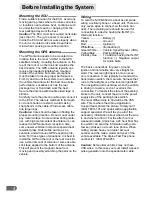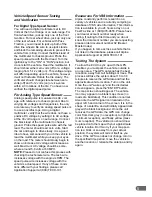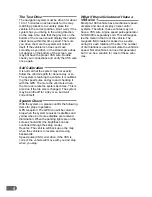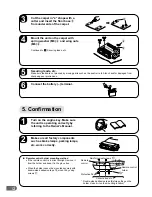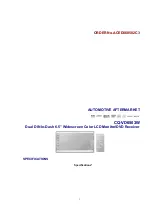
4
Mounting the ECU
Find a suitable location for the ECU. Avoid any
moving parts, places where moisture can arise,
or locations near extreme heat. Locations such
as under the front seats, or hanging from the
rear package tray work the best.
Caution: The ECU must be mounted horizontal
(less than 5˚). The gyro sensor is mounted
inside the ECU and will not work properly when
the unit is mounted on it’s side. Keep this in
mind when choosing a mounting location.
Mounting the GPS antenna
The GPS antenna needs to be mounted in a
location that is the most "visible" to the GPS
satellites. Ideally, mounting the antenna on the
top of the roof or on the trunk lid would be the
best location. The GPS antenna typically can
receive the needed signals when mounted
inside of the vehicle, but some precautions
must be taken to insure proper performance.
First, try and mount the system in a location in
the vehicle that allows for the best line-of-site
performance. Locations such as the rear
package tray or front dash work the best.
Secure the antenna with double sided tape or
silicone.
Carefully route the antenna cable and connect it
to the ECU. The cable is matched to its length,
so do not shorten or extend. Avoid making
sharp bends in the cable. Wind excess cable
into large loops.
Cautions: Care should be taken in finding the
proper mounting location. Do not mount under
any metal surface. Some window tinting mate-
rial, with high metal content like tintanium, can
reduce the GPS antenna’s reception. Also,
some newer vehicles incorporate special heat
resistant glass, Oldsmobile Aurora as an
example, and will cause GPS reception prob-
lems. For these types of situations, it is best to
install the GPS on the roof or the rear trunk lid,
use a small amount of silicone or some double
stick tape applied to the bottom of the antenna.
This will prevent the magnetic base from
moving and possibly scratching the paint on the
vehicle.
Before Installing the System
Wiring
To wire the NVE-N852A is about as simple as
wiring a cellular phone or a head unit. There are
only seven wires to connect on the main har-
ness. The remaining wire should be used for
connecting to a device having the IN-INT (In-
Interrupt) function.
Yellow .................. B)
Black ................... Ground
Red ...................... Ig)
White/Blue ........... Illumi)
Green/White ........ Vehicle Speed Sensor (VSS)
Yellow/Blue ......... Parking Brake (+)
Pink/sky blue ....... To a device having the IN-INT
function (–) Negative output
for Audio Mute
The basic connections for power, ground,
ignition and illumination are very straight for-
ward. The reverse light input is also a neces-
sary connection. It can typically be found at the
transmission switch, the main wire harness that
runs to the taillights or at the reverse light itself.
The navigation unit must know when the vehicle
is driving in reverse, so don’t overlook this
connection. To transmit the state of the parking
brake to the unit, connect the wire to the power
supply side of the parking brake switch.
The most difficult wire to find will be the VSS
wire. This is where the Alpine Application
Support team enters the picture. Simply call 1
(800) TECH-101 and speak with an application
support specialist. We will fax you all of the
necessary information about what color the wire
is and where to find it. For the after hours or
weekend installs, Alpine has a 24 hour Fast Fax
line which can send the information with just a
few key strokes on a touch tone phone. When
calling, please have your dealer account
number and the make, model and year of the
vehicle available. The Alpine Fast Fax phone
number is 1 (800) 978-9655
Caution: Some older vehicles may not have
VSS wires. In this case you must install a speed
pulse generator onto the speedometer cable.




